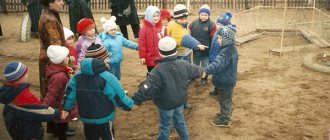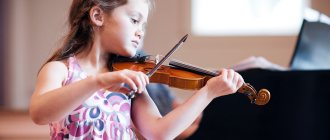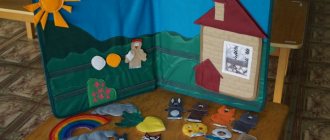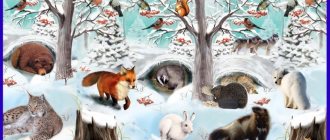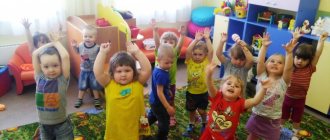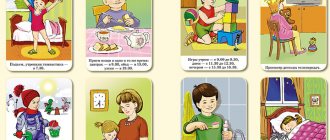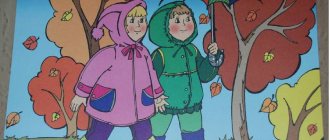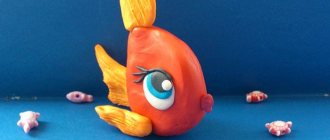Progress of observation
It’s good in the spring, the field is clean, you are decorated with ant-grass.
Yes, all the flowers are fragrant On the May morning, they are dressed up. S. Drozhzhin
The teacher gives the children a task and conducts a conversation.
Explain why people began to dress lighter, why the snow melted? (Due to rising temperatures, warming.)
What happened to the snow? (He melted.)
What happened to the water that formed from the melting snow? (Snow melts into water, water evaporates from the surface of the earth under the influence of sunlight and turns into cumulus clouds in the upper atmosphere.)
What was the sky like? (Bright blue.)
What happened to the soil? (It thawed, warmed up, and began to dry out.)
How has the river changed?
(The rivers opened up and ice began to drift.)
What was the air temperature when it snowed?
At what temperature does it rain?
What is the difference between late spring and early spring? Name these differences. (With the onset of late spring, the sun began to shine dazzlingly, it became warmer. From the spring warmth, the snow melted and ran in streams into the rivers; reservoirs were freed from ice; the soil thawed, the grass turned green, flowers appeared; leaves bloomed on the trees; birds chirped loudly, the first thunderstorms rumbled. )
Labor activity
Cleaning the area of dry branches.
Goal: to cultivate a positive attitude towards work, responsibility when carrying out assignments
Outdoor games
"Penguins with a ball"
,
"Don't step on it"
.
Goal: to make jumping on two legs more difficult while moving forward with an object clamped between the feet.
Individual work
Development of movements.
Goal: to improve jumping on two legs with an object clamped between the feet.
May.
Card No. 4.
Dandelion observation.
Goal: to develop cognitive activity in the process of forming ideas about medicinal plants, the rules of their collection, and use.
Walks in November in the senior group. Card file with goals according to the Federal State Educational Standard
Autumn walks in November. Senior group of preschool educational institutions
Walk #1.
Observing a sparrow in autumn Goals: - continue to consolidate knowledge about the sparrow; - teach to see changes in the behavior of birds with the arrival of autumn; - activate attention and memory. Progress of observation The teacher conducts a conversation with the children. -What does a sparrow look like? (This is a small, lively bird.)
- They often say about him: “gray sparrow.”
But in fact, the sparrow is not gray at all. Which one then? (It has a brown back with wide longitudinal black stripes.)
- What about the tail and wings?
(The tail is dark brown, the wings are also dark brown, decorated with a reddish border.)
- What color is the head?
(Gray.)
- Where do sparrows live?
(In the city and countryside.)
- Yes, they adapt well to human habits everywhere.
Why do sparrows love being around people so much? (Near people, birds are protected from predators, they have food and secluded places.)
- Sparrows especially like to set up their apartments behind the shutters or carved window frames of wooden houses.
Where can city sparrows settle? (Under the canopy of the entrance or balcony.)
- Let's see where the sparrows have taken up residence in our kindergarten territory?
How should a person care for birds? (Make feeders, sprinkle food daily.)
- What do sparrows eat in the fall?
(They peck grains and plant seeds.) Labor activity Organization of a labor landing for the purpose of treating trees. Objectives: - learn how to properly assist trees and shrubs; - cultivate a positive attitude towards work. Outdoor game “Migration of birds”. Purpose: to learn to perform actions on a signal. "Burners" Goal: to consolidate the ability to move according to the teacher’s signal, to follow the rules of the game. Individual work “Don’t knock down the flag.” Goal: learn to walk like a snake between objects without knocking them over.
Walk No. 2.
Observation of pigeons Goals: - continue to consolidate knowledge about the bird world; — clarify what birds eat and where they live, how people care for them, why wild pigeons are listed in the Red Book. Progress of observation The teacher asks the children riddles and asks them to answer questions. A mischievous boy in a gray army jacket scurries around the yard, collecting crumbs. (Sparrow.)
Who flies, who chirps - Does he want to tell us something?
(Magpie.)
What birds most often fly to the site?
Where do they live? What do they like to peck? Who feeds them? Where do pigeons live? Even among ancient people, the dove was considered a symbol of peace and friendship. A bird of rare beauty, it is very easy to habituate and quickly becomes attached to a person. ' But the pigeon has another quality - it is an excellent postman. Man has long noticed the natural ability of the pigeon to find its nest, its home, even at long distances. Do you know that wild pigeons are listed in the Red Book? There are almost no wild pigeons left in nature, and wild pigeons are not found in our area. What feathers in the wings keep a dove warm? Why are pigeons called sisars? Why does the dove soar? Observing the sky and precipitation. Late autumn – pre-winter. The sky is gray and dark. It rains and snows more often. It rains and snows more often. Watch the starry sky. Snow winds are blowing (give the concept of “snow winds”)
.
Poem by G. Ladonshchikov “Late Autumn” : Thin ice lies timidly along the shore. A sad gray cloud floats along the bottom of the pond. Autumn breathes harshly Clear water. The trees have shed their leaves, meeting the cold. Research activity Compare pigeon and woodpecker. Labor activity: hanging feeders on the territory of the kindergarten. Goals: to teach how to perform labor actions. Outdoor games “Fly, jump, swim.” Goals: - to train children in running; - fix the names of fish, birds, animals. "Do not fall". Goal: to strengthen the ability to pass the ball back and forth with straight arms. Individual work “Knock down the pin.” Objectives: - learn to throw the ball at a target;
- develop accuracy and attention. Walk #3.
Observation of the poplar Purpose: to form an idea of the autumn poplar. Progress of observation Under the window a century-old poplar tree has grown, In summer its green leaves rustle. Walking around the city, you will see its fluff - Hundreds of white flies rushing over the street. S. Vasilyeva The teacher asks the children questions. — Where do poplars most often grow? (In the city.)
- What kind of tree is this?
(City.)
- What other trees grow in the city?
— Why are they even needed in the city? (Tree leaves absorb carbon dioxide and produce oxygen.)
- When do the last leaves fall from the poplars?
(Late autumn.)
- What color are the poplar leaves?
(Yellow-golden.)
- Why do the leaves fall from the trees in the fall?
(So that the tree does not lose a lot of moisture in winter.) Observation of frost and hoarfrost. During frosts, frost appears (this is the appearance of ice crusts on trees, on the ground and on all objects)
.
Sometimes it is needle-like. Compare frost with frost (frost on the ground and on the grass)
.
Frost forms in the same way as dew. It can also happen in summer, because these are water crystals (dew when the air temperature is above 0 degrees)
.
Compare the appearance of frost with a decrease in air temperature (monitoring the thermometer)
.
Riddle: There is a village in white velvet - And fences and trees, And when the wind attacks, This velvet falls. (Rime) Research activity Examine through a magnifying glass the branch from which a leaf has just fallen. - What did we see? (Barely noticeable buds.)
What does this mean?
(The trees did not die, they only shed dead, unnecessary leaves.) Labor activity Raking leaves into piles and cleaning them up. Goal: to cultivate a desire to work in a team. Outdoor games “Gardeners”, “Burners”. Goal: practice running at the teacher’s signal. Individual work Jumping on one leg. Goal: practice pushing off energetically and landing correctly.
Walk No. 4.
Observation of seasonal changes Objectives: - to form concepts about natural phenomena (frost, frost, waning day, staying night)
;
— consolidate knowledge about the sun (it shines, but does not warm)
.
Progress of observation Not hot, not summer, Autumn, last, Warm days rise from across the river. A. Isakovskaya
Late autumn is called “silver”.
The first thin ice covers the puddles, silver stars-snowflakes fly onto the frozen ground, icy tree branches ring in the wind, fallen leaves covered with frost glisten in the sun. At the end of autumn, the sun rarely appears and the days become cloudy. The teacher asks the children questions. — What is the name of the pre-winter period? (Silver Autumn.)
- Why?
Try to guess the riddle. And not snow, and not ice, but with silver he will remove the trees. (Rime.)
The teacher invites the children to come up with riddles about late autumn.
Precipitation monitoring. Watch the frost and the first snow. Remember the differences between hoarfrost, hoarfrost, and snow. Note the transition of rain to sleet and relate this to changes in air temperature. Poem by E. Trutneva “First Snow” What is outside the window? Immediately the house brightened - This snow lies like a carpet, the very first, the whitest. This is what the wind was whistling outside my window all night. He wanted to talk about the snow and about welcoming winter. Labor activity : Cleaning up garbage on site. Goal: to cultivate a feeling of pleasure from the work done. Outdoor games : “Trap”, “Homeless Hare”. Goals: - practice running without bumping into each other; - develop agility and endurance. Individual work Exercise to develop balance. Goal: to teach how to run up a hill and run down it.
Walk No. 5.
Observing the first snow Purpose: to teach to notice changes in nature, to see beauty. Progress of observation Yesterday morning the rain was knocking on the glass of the windows, Above the ground the fog rose into clouds. . . . At noon the rain stopped, and like a white fluff, snow began to fall on the autumn mud. The night has passed. It's dawn. There are no clouds anywhere, the air is light and clean, and the river is frozen. I. Nikitin
On the ground covered with snow, everything stopped growing.
But this is not winter yet - pre-winter. Not yet, and it’s a sunny day. And, wow, how happy all living things will be in the sun! Look, mosquitoes are crawling out from under the roots, flies are flying into the air. The snow has melted. . . And at night the frost will strike again. While he is still small, he doesn’t want to yawn. The teacher asks the children questions. — How long does the first snow last? (Two or three days.)
- What does it feel like?
(Wet.)
- When does the first solid snow fall?
(At night.) Research activity Catch a snowflake in your palm and examine it. Compare two snowflakes. Determine the place where the snow melts faster. Find a place where the snow has not yet melted. Watching the sun Continue watching the sun: it shines less and less, it rises low. November has short days and long nights. November is the twilight of the year (discuss with the children why they say this)
.
Riddle: Among the blue field - The bright shine of a large fire. The fire walks slowly here, goes around Mother Earth, and shines merrily in the window. Well, of course, this is... (sun)
Didactic game “Who can name the most actions?”
(practice in selecting adjectives)
.
What can you say about the sun, what is it like? (affectionate, kind, radiant, yellow, red, bright, warm, hot, fiery)
.
Labor activity Insulation of tree roots with snow. Goal: to reinforce the idea of the protective properties of snow. Outdoor game “One, two, three - run!” Goal: to develop running speed, agility, coherence of collective actions, and ingenuity. "Pine cone." Goal: to teach how to make turns clearly and quickly without stopping. Individual work “Hit the hoop.” Goals: - exercise the ability to act on a signal; consolidate the ability to throw objects at a target.
November Walk No. 6.
Observing water Purpose: to form ideas about the aggregate state of water in the autumn. Progress of observation The teacher asks the children questions. — What properties of water are you familiar with? — Does water have a form? — Is the water in a river, lake, sea, or puddle clear? — What happens to water if it is taken out into the cold? The water is clear. Objects can be seen through it. Water is liquid - it does not have its own shape, it takes the shape of the object into which it is poured. On a flat surface, water spreads like a puddle. The water is colorless, tasteless, odorless. Clean water is clear, cloudy and dirty water is not clear. Only dirty water smells bad. Water freezes when the air temperature drops below 0°C. Observation of plants. The plants have prepared for winter. The trees stand without leaves, but there are buds. Examine the buds by shape, size, color. Explain that the trees are no longer growing and are at rest. Reading the poem by A. S. Pushkin “Autumn” : The sky was already breathing in autumn, The sun was shining less often, The day was getting shorter, The mysterious forest canopy was exposed with a sad noise, Fog was laying on the fields, A caravan of noisy geese was stretching to the south: a rather boring time was approaching; It was already November outside the yard. Research activity The teacher invites the children to conduct an experiment. Pour water into a glass jar, close the lid tightly and leave in the cold. Soon the can will split, and instead of it there will be a piece of ice. Frozen water - ice - takes up more space than liquid water, so the ice in the jar became crowded, and it broke it. Ice appears on puddles, rivers, and ponds as soon as the first frost hits. With each frosty day, the ice crust becomes thicker. What happens to ice if it is brought into a warm room? (It will melt.)
The cautious fox went up to the stream to drink, bent down, and the water was motionless and hard.
G. Ladonshchikov Labor activity Cleaning the kindergarten area. Goals: to consolidate skills in working with shovels and stretchers; — learn to rationally organize your work, work together in a team. Outdoor games “Pass”, “Cold - Hot”. Goals: - practice hitting the ball with the inside of the leg lift; - achieve the correct technique in previously mastered types of walking. Individual work Performing exercises to maintain balance. Goal: to develop endurance.
Walk No. 7.
Observing a pedestrian Purpose: to consolidate knowledge about the pedestrian part of the road, traffic rules. Progress of observation The pedestrian must remember: There are traffic signals - Obey them without argument! Yellow light - warning: Wait for the signal to move. The green light has opened the road: the guys can cross! The red light tells us: - Stop! Dangerous! The path is closed! Be careful on the street, children, remember these rules firmly! The teacher brings the children to the pedestrian part of the road and conducts a conversation. — Where are pedestrians supposed to walk? (On the sidewalks.)
You must stick to the right side so as not to stumble, collide, or go around oncoming people, turning to the side.
You need to walk along the street at a calm pace. Cross the road only when the traffic light is green and at a pedestrian crossing. The teacher leads the children to the transition. — How did you know that this is where there is a pedestrian crossing across the road? That's right, there is a sign “Pedestrian crossing” and wide white stripes are drawn on the road. Bird watching. Find out which birds remain for the winter, observe which of them flies to the feeder. Draw the attention of children that it is becoming increasingly difficult for birds to obtain food; discuss how you can help. Poem by O. G. Zykova “Tits” : Oh, and cunning birds, Yellow-breasted tits. Only in very cold weather these birds are friends with the woodpecker. Well, in the summer all the tits can feed themselves. Labor activity Collecting beautiful leaves for the herbarium; raking fallen leaves to the roots of trees. Goal: to cultivate a caring attitude towards nature. Outdoor games “Flock”, “Traffic Light”. Goals: develop dexterity; - consolidate knowledge about the meaning of traffic lights. Individual work Development of movements. Goal: to strengthen the skills of throwing objects at a distance.
Walk No. 8.
Observation of snowfall Objectives: - clarify ideas about the properties of snow; - consolidate knowledge about the seasonal phenomenon - snowfall. Progress of observation Light fluffy white Snowflake, How pure, How brave! On a stormy road it easily flies by, not up to the azure heights - it asks to land... K. Balmont
In the cold season, instead of rain, it snows.
Snowflakes form in the same way as raindrops. At high altitudes it begins to freeze and turn into tiny crystals. These crystals combine to form tiny hexagonal stars—snowflakes—that slowly fall to the ground as snow. The teacher asks the children questions. —Where do snowflakes form? -What do they look like? Observing the work of the driver. Objectives: - clarify ideas about the work of drivers driving different types of cars; - develop cognitive activity; - cultivate interest and respect for the work of adults. Progress of observation We get up very early. After all, our job is to take everyone to work in the morning. The teacher asks the children questions. - Why do you need such a profession? — Should a driver know the rules of the road? — What should a driver know to drive a car well? — What cars can drivers drive? Research activities What kind of snow can you sculpt from? Try to make a ball of snow. Labor activity Collecting snow into a pile to build a slide. Goal: Continue to work together. Outdoor game "Crow - Sparrow". Goals: - teach to listen carefully to the teacher’s command; - develop attention; - continue to learn how to navigate in space. “Dashing and catching up.” Goal: to learn to coordinate your actions with the actions of your comrades. Individual work : “Don’t knock down the flag.” Goals: - continue to walk like a “snake” between objects without knocking them over;
Walk No. 9.
Observation of a dog Objectives: - to teach to establish a connection between the appearance features, behavior of animals and the conditions of the winter season; — to cultivate interest in the life of animals, love, and the desire to help in difficult conditions. Progress of observation In our house, adults and children know that I am now the happiest person in the world: I, to the envy of all dog breeders, have a dog of an amazing breed. The teacher asks the children questions.
— What is the name of the dog’s home?
— What is a dog’s favorite treat? -What does the dog look like? What breeds of dogs do you know? — Why are some dogs called “strays”? A dog's happy life largely depends on its owner. Dogs eat a variety of foods. They can enjoy fruits, cereals, milk, cottage cheese, but most of all they love boiled meat. There are a lot of dog breeds - St. Bernard, Dachshund, German Shepherd, Chow Chow, Poodle, Rottweiler, they are all different from each other. The dog is smart, attentive, has an excellent memory, subtle sense of smell, and acute hearing. She will never leave her master in trouble, will never betray him! There are people who throw animals into the street. Animal life becomes painful. They don't have good food, warmth, affection, they have to live in the basement and on the street, they get sick and die. This is the result of human callousness. And that's why I want to appeal to everyone. Don't throw away your pets! Labor activity: Shoveling snow into a certain place to build ice figures. Goal: learn to work together, achieve goals through common efforts.
b] Outdoor games “We are funny guys”, “Entertainers”.
Goal: learn to clearly speak the text in the game, follow the rules of the game. Individual work Development of movements. Goals: - improve techniques for throwing objects at a horizontal target;
- develop eye, coordination, dexterity; - develop a positive attitude towards physical exercise. Walk No. 10.
Observation of coniferous and deciduous trees Purpose: to develop knowledge about trees (what they have in common and what are their differences)
.
Progress of observation The teacher asks the children questions. — What trees grow on our site? (Birch, aspen, pine, spruce, larch, etc.)
- What kind of trees are these?
(Coniferous and deciduous.)
- How do deciduous trees differ from coniferous trees?
- What do they have in common? (Trunk, branches, root.)
- What conditions are necessary for trees to grow?
— What benefits do coniferous and deciduous trees bring in the national economy and medicine? Continue to establish a connection between the height of the sun and air temperature. For this purpose, carry out long-term observations (at the beginning, middle and end of the month)
.
Select a specific place, time and landmark (the sun is above a specific house: we record the date and time in the observation album and measure the air temperature)
.
Bring children to the conclusion that the lower the sun is, the lower the air temperature (recorded in the observation diary)
.
Cat observation. Objectives: - to consolidate knowledge that a cat is a domestic animal, a mammal, and has certain characteristics; — to cultivate humane feelings towards animals that have been tamed by humans. Progress of observation The teacher asks the children a riddle and asks them to answer questions. Even though I have velvet paws, they call me “scratchy”, I deftly catch mice, I drink milk from a saucer. (Cat.)
Why is a cat a pet? What does a domestic cat look like?
What do cats eat? What are baby cats called? What breeds of cats do you know? What benefits do cats bring to people? What wild animals are close relatives of the domestic cat? Prove that the cat is a predatory animal. Compare the abilities and personalities of dogs and cats. What songs, poems, riddles, fairy tales about cats do you know? Labor activity Cleaning at the physical training area. Goal: learn to work together, distribute responsibilities among themselves. Outdoor games “Rush”, “Catch up with a couple”. Goal: practice running over obstacles. Individual work Standing long jump. Goals: - practice jumping, pushing off with both legs;
- improve coordination of movements. Walk 11. Helicopter observation
Objectives: - consolidate knowledge about air transport; — to develop interest in the pilot profession. Progress of observation The teacher asks the children a riddle and asks them to answer questions. It will fly up without acceleration - it reminds me of a dragonfly. (helicopter)
is taking off .
— What does the helicopter look like? (Large, with a large propeller at the top.)
- How is a helicopter similar to a dragonfly?
(Appearance.)
- What types of helicopters are there?
(Sanitary rescue, military, cargo.)
- What is the profession of the person flying the helicopter?
(Pilot.)
- What other types of transport do you know?
(Ground, water, underwater.)
- What are the differences between a helicopter and an airplane?
(An airplane has more speed than a helicopter; a helicopter can hover in the air, but an airplane cannot; an airplane needs a runway to take off, but a helicopter can take off.) Observation of trees. Which tree was the last to shed its leaves? Conclude that after the air temperature dropped below zero degrees, all the trees lost their leaves. Draw the attention of children that young branches do not grow on trees, the buds on the branches are tightly closed. Didactic game “Smart Vocabulary” - practice selecting nouns; enrich children's vocabulary. Leaves of a plant, tree, bush - (foliage)
.
Falling leaves in autumn - (leaf fall)
.
Precipitation in the form of water droplets - (rain)
.
The movement of air over the ground is (wind)
.
A large dark cloud from which rain, snow, or hail may fall. - (cloud)
.
A bright light in the sky during a thunderstorm, accompanied by thunder - (lightning)
.
Labor activity: Site cleaning. Goal: to strengthen the ability to work together. Outdoor games "Airplanes". Goal: practice running with words. "Blind Man's Bluff." Goal: to teach how to navigate in space with your eyes closed. Individual work “Cross the river”. Goal: practice walking on a log straight and sideways.
Walk 12. Observation of snow and ice
Objectives: - consolidate knowledge about the various states of water; — to form a realistic understanding of inanimate nature. Progress of observation The teacher asks the children questions. -What does ice consist of? — What properties of ice (snow)
are you familiar with?
— How are snowflakes formed? We are snowflakes! This is us - the parachutes of winter. It is we who are circling above you, It is we who are friends with the winds. Ice is frozen solid water; as soon as you warm a piece of ice in your palm, it will immediately flow from your fingers in a thin stream. Signs of ice: shine, smoothness, hardness, fragility. Pat the surface to determine smoothness. Impact to detect strength and fragility. Water evaporates from the seas and oceans. Water vapor rises high above the ground, where it is always very cold. There, at altitude, the steam freezes into tiny ice crystals. The crystals join together to form stars-snowflakes. —What is snow like in warm weather? (Sticky, heavy, wet, damp.)
- What is snow like in frosty weather?
(Dry, fluffy, light, crumbles.)
Dense, trampled snow melts more slowly than loose snow;
dark dirty snow melts before clean and light snow. Observing the work of a janitor Goals: - expand knowledge about the work of adults in the fall; - cultivate respect for work. Progress of observation The wind plays with the leaves, tears leaves from the branches, yellow leaves fly straight into the children’s hands. The teacher asks the children questions. — What tools does a janitor need to work? — What work does a janitor do in the fall? — What is the work of a janitor needed for? — How can we help the janitor? Research activity Compare the freezing time of clean and colored water in large and small molds. Compare the rate of melting of snow packed tightly or loosely in a glass. Labor activity Caring for plants growing on the site. Goal: to develop interest in working in nature, environmental awareness. Outdoor games “Wolf in the Moat”, “Mousetrap”. Objectives: - teach how to jump over a ditch and back when given a signal; - develop speed, agility, endurance. Individual work Lasagne. Goals: - develop coordination of movements;
Walk No. 13.
Observation of the forest in late autumn. Goals: expand the idea of the autumn forest; teach to see the beauty of the autumn landscape. Progress of observation: Bring the children to a place where the forest is clearly visible. Pay attention to the beauty of the forest in late autumn. The trees “put on” their winter attire, snow covered their tops, everything was white and white all around, and only the fir trees and pine trees were still green. Labor activity Making snow buildings - learn how to properly carry snow for construction, help comrades in performing labor actions; Outdoor games “The Third Wheel” - teach to follow the rules of the game “Find Us” - fix the name of objects on the site, orientation in space. “The deer has a big house” - consolidate the ability to correlate movements with the text. Individual work for “Goats” is to train children in jumping over 2-3 objects in a row. Drawing in the snow - invite children to make drawings in the snow with sticks, to maintain interest in drawing. Games at the request of children - teach children how to find
We recommend watching:
Summary of an autumn walk in the senior group Autumn excursion to the forest with preschoolers of the senior group. Summary Autumn walk in the senior group “What autumn gave us” Walks in September in the senior group. Card file with goals according to the Federal State Educational Standard
Similar articles:
Walking in the senior group. Card file with goals for September
Walking in the senior group. Card index with goals for October
Walking in the senior group. Card index with goals for November
Autumn walk “Watching the sky” in the senior group
Autumn walk “Watching the rain.” Senior group
Progress of observation
Yellow head, pink leg.
Dandelion-sun I’ll hold it in my palm.
The sun appeared in the meadow in May,
I admire it, I take great care of it.
It's a pity, the sun won't be golden for long,
The sun will turn white - And I will part with it. V. Miryasova
The dandelion is called the sun because its flower is yellow, round and similar to the sun. First, a green bud appears, which opens into a yellow flower, then white fluffs appear in place of the petals - umbrellas, with the help of which the wind carries the seeds of the flower.
Dandelion officinalis is a perennial herbaceous plant that grows throughout our country. The raw materials are roots. A decoction of dandelion roots is used as a bitter to stimulate appetite and improve digestion. Roots and rhizomes can be harvested only after the seeds have ripened and fallen off; it is advisable to leave some of the roots and rhizomes in the ground for plant regeneration.
Bike monitoring
Goal: to consolidate knowledge about the purpose of a bicycle.
Progress of observation
The teacher asks the children a riddle and asks them to answer questions.
He is a real worker
Very, very hard working.
Under a pine tree in a dense forest,
He builds a house from needles. (Ant.)
What benefits do ants bring to people and the forest? (Destroy harmful insects.)
Which forest dwellers love to eat ants and their larvae? (Bear, woodpecker.)
The anthill is ruled by the ant princess. When she was young, she had small wings and loved to frolic and fly. But, having become the mother of a large family, the ant gnaws off her wings, and from then on lives in an anthill. She lays eggs, from which larvae later emerge. Worker ants take care of the younger generation - they feed and care for the larvae. The ant tower is guarded by soldier ants, these fearless defenders of the fortress. Ants are predators and destroy many insects.
Where do our ants live? (The anthill is located in the top layer of soil, under the asphalt.)
Let's watch how the ants work. They crawl along paths that they have gnawed into the asphalt .
Rainbow watching
Goal: to continue to form an idea of the rainbow as part of inanimate nature.
Types of organized activities for children during a walk
The structure of the educational program of the kindergarten involves the organization and combination of 4 types of activities for children during walks in different combinations.
Observation
Regarding the disclosure of the theme of the walk, observation as an organizational stage is in first place among other types of activities . On walks with children 5–6 years old, the following objects are considered:
- animals, plants, insects living in the area;
- precipitation (snow, fog, rain, etc.);
- the process and results of the work of representatives of different professions (builder, driver, janitor, etc.);
- remarkable places of the native land.
When choosing an object to consider, the organizer of the walk determines its type:
- short-term observation (for example, the position in space, size, shape of an object);
- long-term (for example, accumulation of information about the development cycle of a plant from seed to flower or bush).
For a correct analysis of the facts, it is important that the children in the senior group adhere to the algorithm for obtaining information during observation:
- Tracking facts and phenomena. For example: flying leaves, sudden changes in weather, short-term rain.
- Establishing a relationship between the observed elements: leaves fly off more intensely, and it becomes colder with strong gusts of wind.
- Accumulation of data on the phenomenon: the wind also drives clouds, which means it may start to rain.
- Comparing data with each other and with already known information (or trying to determine what young observers already understand and what has just been discovered).
- Formulation of conclusions (one of the signs of autumn is a strong wind, which is a harbinger of changing weather conditions, causing leaves to fly around and bringing probable rain).
Experiments
In order for the observation stage to be most productive, it is supplemented with experiments, during which children come to certain conclusions in practice. The use of this technique is especially effective when the topic of the walk coincides with the topic of the lesson on the environment. The children are happy to be involved in experiments, and yet methodologists do not recommend conducting more than 3-4 experiments per month, since satiety may set in.
There should not be too many experiences, otherwise the children will get fed up with them
Table: card index of experiments during a walk in the senior group (fragments), author Olga Ivanovna Ivanova
| Name | Target | Materials | Content | Bottom line |
| "Properties of Water" | Introduce children to the properties of water (takes shape, has no smell, taste, color). | Several transparent vessels of different shapes, water. | Pour water into transparent vessels of different shapes and show the children that the water takes the shape of the vessels. | Water has no form and takes the shape of the vessel into which it is poured. |
| "Sand Cone" | Set the properties of sand. | Clean sand. | Take a handful of dry sand and release it in a stream so that it falls in one place. Gradually, a cone forms at the site of the fall, growing in height and occupying an increasingly larger area at the base. If you pour sand for a long time, then in one place, then in another, alloys appear; the movement of sand is similar to a current. | Sand can move. |
| "Life cycle of flies" | Observe the life cycle of flies. |
| Peel the banana and put it in a jar. Leave the jar open for several days. Check the jar daily. When the fruit flies appear, cover the jar with a nylon stocking and tie it with an elastic band. Leave the flies in the jar for three days, and after this period, release them all. Close the jar again with the stocking. Monitor the jar for two weeks. | After a few days you will see larvae crawling along the bottom. Later, the larvae will develop into cocoons, and eventually flies will appear. Drosophila are attracted to the smell of ripe fruit. They lay eggs on fruits, from which larvae develop and then pupae are formed. Pupae are similar to cocoons into which caterpillars turn. At the last stage, an adult fly emerges from the pupa, and the cycle repeats again. |
| “Dependence of snow melting on temperature” | Bring children to understand the dependence of the state of snow (ice) on air temperature: the higher the temperature, the faster the snow will melt. | On a frosty day, invite children to make snowballs. Why don't snowballs work? The snow is powdery and dry. What can be done? Bring the snow into the group, after a few minutes we try to make a snowball. The snow has become plastic. The snowballs were blinding. Why did the snow become sticky? | The condition of the snow depends on the air temperature. The higher the temperature, the faster the snow melts and changes its properties. |
Labor activity
In the process of implementing this stage of the walk, kids learn to take responsibility for completing a particular task, and also, having realized the expected result, select the right tools and carry out the sequence of operations to implement the task. In other words, if the teacher gives the order to clean up the area, the kids take brooms and dustpans and use them for their intended purpose.
Types of work for children 5–6 years old:
- caring for flower beds (watering, for example);
- cleaning up garbage (janitors do this work regularly, so kids can only sweep away leaves from benches, rake snow or remove dust from toys on the territory);
- replenishing grain supplies in bird feeders (children regularly pour grain into birdhouses);
Caring for birds is part of the work block of the walk
- sorting and folding game material before returning to the group.
Play activity
This stage traditionally takes the most time. Games can be active with jumping, elements of running (in good weather) and calm without sudden movements and the need for extensive free space (if it was raining the day before, for example, and now it’s slushy). The latter include skittles, towns, etc.
In the older group, children are introduced to 3-4 new games per week, and most of the fun is competitive.
The most famous outdoor games in Rus' were heroic games
Video: outdoor games for walks
Individual work
This stage of the walk involves a selection of tasks that will help identify children’s preferences by involving them in different types of activities. For example, some of the children will be happy to play with the ball, while the rest will enthusiastically catch butterflies.
All activities can be accompanied by music. That is, the teacher pre-selects melodies suitable for the rhythm for each type of activity, or makes part of the task of the game stage musical (for example, a competition - who can dance the longest on a newspaper / tile, as well as a competition in the sense of rhythm, when kids must change the style of dance in depending on the piece of music heard).
Summer afternoon walks usually include playful and individual activities. This is due to the fact that children are picked up at different times, which means that it is difficult for the teacher to coordinate not only the children’s activities, but also to pay attention to mothers and fathers who are interested in how their child’s day went.
The development of tasks for individual work should be based on knowledge of the temperament and character of children
Progress of observation
The teacher asks the children a riddle.
What a miracle - beauty!
painted gate
Showed up on the way
You can't drive into them or enter them. (Rainbow.)
When it rains and the sun shines, a rainbow may appear in the sky. It is visible when the sun's rays pass through raindrops. The larger the raindrops, the brighter the rainbow. There are seven colors in the rainbow - red, orange, yellow, green, blue, indigo, violet. They are always located in the same order.
The sun ordered - stop! — The Seven Color Bridge is steep. A cloud hid the light of the sun - The bridge collapsed, but there were no chips.
Labor activity
Cleaning the site area.
Goal: to cultivate the desire to work, to collect all the garbage so that it is clean.
Outdoor games
“Carry it, don’t drop it”
,
"Firefighters"
.
Goal: to teach climbing by “rolling”
through an obstacle.
Individual work
Development of movements.
Goal: improve climbing skills on a gymnastic ladder.
May.
Card No. 7 .
Watching a dragonfly.
Goals:
— expand knowledge about the appearance of dragonflies;
- cultivate an attentive and caring attitude towards all living things.
Theoretical aspect of preparing and conducting a walk
A walk is the most suitable way to introduce children to the nature of their native land. This is why regular outdoor activities are an important component of the kindergarten educational program. The duration of the walk in the older group is 3–4 hours in the summer (before lunch and after a nap) and 1–1.5 hours in the winter (only before lunch).
The duration of the walk depends on the topic and type of leisure activity, for example, a target walk lasts a little longer than a regular daily walk
Why do preschoolers need walks?
In addition to the main purpose of taking walks in kindergarten, namely increasing immunity and improving general health, outdoor leisure contributes to the implementation of the triune direction of the educational process:
- Teach kids to find, record and analyze changes in the world around them associated with the change of seasons and human activity (for example, by removing leaves from a park bench, a janitor made it possible to use it for its intended purpose).
- Work to develop and improve the skill of observing nature, people, space.
- Fostering a positive attitude towards people, animals, plants, as well as the results of human labor, aimed at preserving and increasing existing natural and material wealth.
Playing games together fosters a positive attitude towards each other and the people around you.
Walking tasks
In order to achieve the set pedagogical goals, the teacher solves a number of educational tasks at each walk, as well as during preparation for it:
- Shows children the uniqueness of nature in all its manifestations.
- Shows interesting places in his native land, presents the results of the work of people who are engaged in landscaping and improving the city, town, village, village.
- Teaches you to analyze observational facts and draw conclusions on this basis (for example, to understand that, despite the differences between spruce and pine, they have a lot in common, which means they are “relatives”).
- Continues to teach children the ability to dress for the weather.
- Finds ways to improve the culture of health, in particular, through developing the habit of relieving yourself and cleaning your nose before going out.
- Instill a responsible attitude towards coexistence with the outside world.
Walking requirements according to educational standards
For productive leisure time on the street, the Federal State Educational Standard (FSES) defines 4 conditions:
- Each age category of children should have their own separate area.
- Children should have a sufficient selection of toys for playing in the sandbox (moulds, buckets, shovels and scoops).
Playing with sand is important for the development of a child’s fine motor skills, so there should be a sandbox in every area
- On the territory of the group site there should be a gazebo that hospitably welcomes children and adults in case of unexpected bad weather.
- Purity. Special attention is paid to this parameter: janitors regularly clean the area, and teachers monitor the condition of the area throughout the day.
Types of walks
- Daily walks - regardless of the season, but keeping an eye on the weather.
- Sports walks organized on the street. On average, there are 3-4 such “outings” per academic year. In the older group, children are involved in activities that involve competition, such as relay races.
- Targeted walks: during them, children and a teacher go outside outside their area, for example, to a park, a museum, etc. If the walk is long, the route is additionally agreed upon by the teacher with the kindergarten administration. Also, during such a walk there must be at least two adult accompanying persons.
- Unusual walks. The main condition for carrying out these is the creation of an unusual situation of going outside. For example, going to visit some fairy-tale character and completing tasks along the way. Often these outings are accompanied by a costumed transformation, when a teacher or a guest animator plays the role of a fairy tale character.
An example of a non-standard winter walk - a trip to visit Zimushka-Winter
